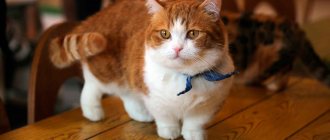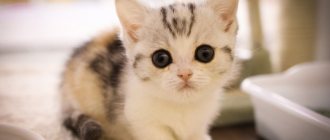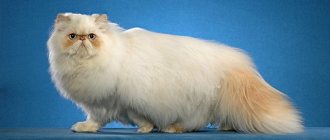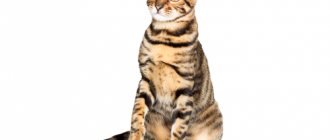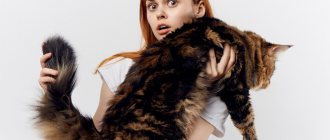| Origin | UAE |
| Wool | short, hard, without undercoat |
| Dimensions | medium, 25-30 cm at the withers, 4-8 kg. |
| Lifespan | 10-15 years |
The Arabian Mau is an old desert breed that was created in natural conditions, without targeted breeding. As a modern breed, it was recently recognized by the World Cat Federation. It has another name - Arabian Mau, which, like the main one, also indicates the place of origin of the breed.
History of the Arabian Mau breed
The Arabian Mau is a breed of short-haired cat of indigenous origin. The Arabian Mau is believed to have descended from the wild steppe cat of the Arabian Peninsula. Wild cats used to live in deserts and steppes in the Middle East (United Arab Emirates, Oman, Qatar and Kuwait). These cats are believed to have originated over 1,000 years ago.
Arabian Mau originated naturally
As cities grew, wild cats began to choose habitats closer to people. There was more food in populated areas, and it was more comfortable to sleep in a warm house than on the street. Local residents are so used to animals that they stopped paying attention to them. It was considered fashionable to purchase purebred cats and cats brought from abroad.
It was only in 2004 that attention was paid to street Arabian cats. The president of the Middle Eastern Cat Fanciers Association (MECATS), Petra Muller, organized a real wild cat nursery and began breeding and preserving the breed. The official breeding program for these animals gained momentum; in 4 years, 4 generations of animals (18 individuals) were obtained. In 2008 the breed was officially recognized by the WCF.
Despite the fact that Arabian cats are mostly strays, they are loved and respected. Arab Muslims believe that the Prophet Muhammad had a cat named Muezza. The great prophet cut his sleeves so as not to wake up the cat sleeping on him. That's why even stray cats are allowed into the mosque. In our city (Penza) the doors of mosques are open to any cats. This suggests that the first cats appeared a long time ago, becoming the object of ancient legends.
Character
Arabian cats adore small family members. If there are already other pets in the house (for example, hamsters or rats), then it is not recommended to get a cat of this breed together with them.
Their extraordinary hunting instincts make them perfect for living in a large yard of their own. If a cat is purchased to live in an apartment, it needs daily walks like air. Mau prefer to make high jumps, like their savannah counterparts. When getting a pet, you should be prepared for this.
Arabian cats are distinguished by high intelligence. They are easy to train, which is why they are often compared to man's best friends - dogs. Qualities such as curiosity, a sharp and inquisitive mind, and non-conflict nature make this breed one of the most beloved. The Mau cat easily gets along with other pets and children. However, the animal will not tolerate an overly familiar attitude towards itself.
They choose one owner, to whom they give their tenderness and affection. These cats are sociable and friendly, they are ideal as a companion for a lonely person. Their loyalty knows no bounds. Mau will be happy to accompany the owner anywhere and everywhere - on vacation, at home, while watching favorite TV shows, cooking, repairing, and entertaining.
One of the characteristics of this breed is their silence. With this quality they are somewhat similar to the Burmese cat. Mau will not bother their owners with excessive meowing. However, an animal of this breed will not lie down and purr in the owner’s arms for several hours; most likely, it will settle down nearby. Cats behave with curiosity around strangers, they are not afraid and are willing to be handled.
Description of the Arabian breed
The appearance, character and habits of the animal were formed over many years. The first Arabian cats were unadapted to life in the wild desert conditions. Desert dune cats bred with domestic pets, passing on beneficial genes to Arabian cats. Nature did the rest. The cat's physique, intelligence and even color allow it to survive in any hot conditions.
The appearance of the modern Arabian cat is the result of natural selection
Appearance of Arabian cats
Arabian Mau cannot be called small cats, although they are slender. The weight of an adult male can reach 8 kg, females - 4 kg. The slender Arabian woman looks graceful. The cat seems even more graceful thanks to its slender limbs and elongated, elongated body. The cat's body is not thin, it is quite muscular.
The animal's tail is of medium length and tapers towards the tip. People who do not understand breeds, when they see an Arabian cat for the first time, will decide that this is an ordinary yard cat. However, there are a number of striking characteristics that distinguish this animal from representatives of other breeds.
Yes, their color, in general, is reminiscent of Russian courtyards, although it seems to me that this is precisely the peculiarity of the Arabian Mau - very clear spots, most often black and white, I have observed many cats that resembled cows in color.
Arabian Mau, forum user
https://mauforum.ru/viewtopic.php?p=692730
The main distinguishing features of Arabian cats are huge ears and a sharp chin.
The cat's head is round with well-defined whisker pads. The profile is curved, the chin protrudes noticeably. Arabian cats have large, wide-set ears with a rounded, drooping tip. This shape of the ears allows the animal to cool itself in the hot climate of the United Arab Emirates. The animal's eyes are large and oval, and the color of the eyes does not depend on the color of the coat. Most often, Arabian women have green eyes.
The Arabian Mau's coat is short, smooth, silky and slightly rough to the touch. Animals do not have undercoat (it is not needed in hot climates). Due to the lack of undercoat, Arabian cats hardly shed. They also don't have dandruff. For these reasons, the unusual long-eared cat is considered hypoallergenic. The color can be any, but the most common options are:
- white (completely white wool without any inclusions);
- black (charcoal black without “rust” and gray inclusions);
- black and white (the combination of spots can be absolutely any);
- red-brown (tabby with small stripes along the back);
- gray-white (a combination of spots of any shape and absolutely any size).
Photo gallery: Arabian Mau main colors
Most tricolor Arabian cats still live on the streets
In gray and white Mau, the colored areas may be solid or striped. In gray Mau with a tabby pattern, there may be patches of tan color
The eye color of Arabian cats does not depend in any way on the coat color.
Most often, Arabian cats are found with a tabby pattern.
Fun fact: Most cats living in hot climates wear tabby coats. This is due to the fact that animals have been forced to cope with the heat for centuries. Dark stripes in a cat's color absorb heat, while light stripes repel it. This alternation results in a flow of air along the cat's body. Even despite the high temperature of this stream, the cat experiences something like a “draft”. This is how the cat's body cools down.
Character of the Arabian Mau
Because of their indigenous origins, Arabian cats are excellent hunters. Their wild ancestors spent all their free time hunting. Therefore, the Arabian pet is ideal for keeping in a private home; the cat will catch all the rats and mice. In addition, these cats are intellectually developed and are easy to train. Due to their intelligence, these cats are sometimes compared to dogs.
However, Arabian cats cannot be called wild, because they have a soft and pleasant character. Such a cat will become an affectionate and loving pet, devoted to its owner. In addition, Arabian cats get along well with children and other pets, especially dogs.
The Arabian cat will become a good friend of children and an excellent guard for a private home.
A distinctive character trait of the Arabian cat is silence. The animal will not bother its owner with heartbreaking screams, even if it urgently needs help. However, such a cat does not like loneliness; she prefers to spend time with her owner. But the Arabian cat will not lie on your lap, purring contentedly from being stroked. The favorite place of such a cat is next to the owner, but no closer than arm's length.
And the Arabian Mau perfectly adapts to any new conditions. A naturally curious cat puts all her energy into learning new things. Cats love making new acquaintances, so any guest will be greeted with curiosity and goodwill.
Video: Arabian Mau named Puma plays
Details
Features of Mau appearance
The current standard for the Arabian Mau cat breed gives the following description of the standard:
- The head is wedge-shaped, with an elongated profile with a defined chin and moderately pronounced whisker pads. The forehead is narrow, flat in shape, the nose is of medium length.
- Large oval shaped eyes. The iris of any shade should be in harmony with the color of the coat.
- The ears are large, set wide and at an angle. There are no tassels, the inner edge is moderate.
- The body is dry, muscular, all lines are toned. Strong neck of medium length.
- Long legs, straight and well muscled. The pads of the limbs are elongated.
- The tail is wide, the length should be equal to the length of the body.
- The coat is short without undercoat. The fur is hard to the touch. Kittens are born with an elongated pile, which by the age of one year completely changes to an adult short one.
- Any color, but most often corresponds to the Van variant - white body and red limbs and spots.
As for size, the breed falls into the medium category. Cats are always smaller than males, weighing up to 6 kilograms. A cat can grow up to 8 kilograms.
IMPORTANT: individuals with soft fur and an excessively graceful body can be excluded from breeding.
Individual characteristics of character and habits
The most important characteristic of the breed is that they are hunter cats. The wild roots are so close that not one of the titled exhibition representatives of the breed has yet lost their talent for tactical extermination of mice on their territory. It is ideal to keep the breed in the house and give it the opportunity to walk in the territory at any time of the day.
The second advantage of the proximity of aboriginal roots is a flexible mind. If you start training a kitten on time, you can achieve very good results by the age of one year. Even the basic commands of a dog training course are within the capabilities of the breed.
The Arabian cat breed becomes attached to the family very quickly. The cat usually doesn’t have favorites; she gets along and is affectionate with everyone, including children. Can live with dogs.
Many owners note the breed's silence
Again, the habit of not making sounds is directly related to the long residence of the breed’s ancestors on city streets, where attracting attention with one’s voice is useless, and more often than not, simply dangerous.
The breed treats guests with interest. In general, for the Arabian Mau, a change of environment is not a problem. You can easily take your pet with you on trips.
House maintenance - how to organize daily life for the breed
The Arabian Mau breed is self-sufficient and largely independent. It does not require any special conditions; it is enough to maintain minimal external hygiene and create a balanced diet.
There are only a few aspects of nutrition that need to be considered to keep the breed healthy. Firstly, the breed is omnivorous, but this does not mean that you can give everything that is left from your table. A regular cat diet of dry, wet or natural food is suitable for the breed.
The second point in matters of nutrition is to avoid overeating. Watch portion sizes and monitor your pet's weight. Due to the fact that for centuries the Mau have been getting food for themselves, spending a lot of energy on it, at home, with plenty of feeding, they easily become obese.
Hygiene with the breed is not difficult. Coarse wool is brushed with a special brush once a week. After combing, you can walk with a damp towel to collect dust and dirt. This procedure will also help to bathe the Mau as rarely as possible, because the desert cat’s skin has an extremely negative attitude towards water.
Rubbing the eyes, ears and brushing teeth can be done as they become dirty, but it is better to accustom the cat to these procedures every other day.
The breed requires veterinary support once a year, unless specific cases of disease arise. Mau immunity is strong, timely vaccination and routine examinations can protect them from most diseases.
Purchasing kittens
The nearest breed kennel is located in Dubai. It is there that you can easily buy Arabian Mau kittens for only 60,000 rubles apiece.
The most famous and authoritative kennel belongs to the founder of the exhibition version of the breed, Petra Müller. The price for a kitten from it will be significantly higher.
Unfortunately, the breed is historically valuable, but has little competitiveness among many other cat breeds. Natural agility and fighting character are not supported by any expressive features of appearance, so the conquest of the world is very slow.
Buying an Arabian kitten
An Arabian cat kitten is not cheap. The average price for such a pet is 60,000 rubles (it all depends on the class and gender of the animal). But even if a person decides that buying an unusual kitten fits into the family budget, then the next problem will be finding a nursery. The fact is that so far in Russia, Ukraine and Belarus there are no organizations professionally involved in breeding Arabian cats.
The largest number of Arabian Mau (more than 100 individuals) is kept in the nursery of Petra Muller (Dubai). Even “smaller” nurseries are also located in Arab countries, so you need to look for the mysterious cat there. Nowadays it is not so difficult to get to warmer climes (many families spend their annual holidays this way). If it is not possible to get there in person, for example, in Dubai, you can hire a courier or turn to intermediaries. In any case, it is recommended to clarify information about the reputation of the nursery, since in some Arab states there are restrictions on the registration of nurseries.
Unfortunately, no one takes care of these cats in the Emirates. There is no talk of any breeding, firstly, why breed if there are already plenty of them on the streets, and secondly, the laws of the UAE prohibit the sale of animals without a special license from a pet store (which requires registration, renting premises and paying the appropriate fees). Otherwise, animals can only be given as a gift or given away for free. Therefore, there are no official nurseries in the Emirates.
Andastra, forum visitor
https://mauforum.ru/viewtopic.php?p=692730
"Real" Arabian kittens can only be found in Arab countries
Criteria for choosing an Arabian kitten
If you have decided on a nursery, you can start choosing a little Arabian. The ideal representative of the breed must meet several criteria:
- healthy appearance (clean ears, nose and eyes, no traces of fleas or wounds on the kitten’s body);
- availability of documents (veterinary passport with vaccinations and pedigree);
- the presence of characteristic features of the breed;
- suitable age for the kitten.
Even the smallest Arabian kitten should be recognizable as a representative of an ancient breed. The kitten should not have undercoat. A baby's coat may be soft, but as it grows it will become coarser and spikier. Even the tiniest Arabians should have large triangular ears. The tips of the ears should be slightly tilted forward. The kitten's muzzle should be pointed; Arabian kittens cannot have a “square” muzzle. And Arab kids are rarely “fuckers.” Most representatives of the breed have been naturally thin and slender since childhood. Moreover, the kitten should not have ribs or shoulder blades sticking out, its body should simply be elongated and thin.
A kitten’s belonging to an indigenous breed should be guessed from early childhood
The age of a kitten at which it is better to adopt it
Breeders of any cat breed believe that kittens can be given away no earlier than they reach three months of age. Veterinarians agree with this, because it is at 3 months (12 weeks) that the kitten receives vaccinations, on which the baby’s life depends. Some people try to persuade the breeder to give the baby away earlier, believing that they can carry out such an important vaccination themselves. But not everything is as simple as it seems. The fact is that the three-month age for vaccinations is closely related to breastfeeding a kitten. The first two months of life, the kitten receives antibodies from the cat's milk. This is the only way to obtain immunity at this age. And by the third month, the concentration of antibodies in milk decreases.
In addition, while the cat feeds the cub herself, she cares for him in a way that a person cannot do. The cat “washes” its baby, monitors its behavior and teaches everything that it knows how to do. Only a cat can correctly and carefully teach a kitten to visit the litter box, play, behave, etc. A mother cat sets an example for her offspring in everything, including in communicating with people. If you tear a kitten away from its mother too early, it will not know that the person is a friend. Such kittens can grow up to be aggressive or, conversely, too apathetic.
A kitten separated from its mother early can experience serious psychological stress. This will affect the kitten’s well-being. Such babies weaken and become a target for germs and various infections. It will be doubly difficult for a small animal to cope with diseases. My family had this experience. The month-old kitten my father brought in died just a few days after the move. This was a necessary measure, since the cat was left without a mother, but it was too early to vaccinate.
Little Arabian kittens become vulnerable without their mother
Historical reference
The Arabian Mau cat is a descendant of a species of desert predators that evolved from common wild cats. Adaptation to a hot climate was accompanied by changes in appearance - large ears for rapid cooling, thick skin on the paw pads and striped coloring.
There is no exact data on the pedigree of the Arabian Mau due to the age of the breed. It is assumed that the short-haired cat, which entered the territory along with people, was unadapted to survive in desert conditions. However, free matings of wild desert cats (the modern velvet cat) and domestic pets gave the world the ancestors of the Arabian Mau.
The human species is perhaps the most unpredictable on the planet, why chase the unattainable when the best is nearby? This question can be asked of all people, and in relation to the Arabian Mau, their “neighbors”, the population of the UAE and surrounding areas
People stubbornly ignored universal, healthy, “working” cats, chasing breeds exotic for hot countries, only Petra Müller paid attention to “indigenous cats.” Petra was the director of MECat (Central Asian Cat Society) and observed Mau for several years
An experienced look and feminine intuition told Petra that Arabian Mau were not just “yard cats.”
Realizing that a “simple” tabby cat had little chance of recognition, Petra Müller chose a more difficult but reliable strategy. Having selected 40 “ideal” representatives of the breed and waited for 4 generations of kittens, Petra drew up a standard and a petition to the WCF (World Cat Federation). 20 animals from 4 generations of Arabian Mau were presented to the experts. However, the experts found that little work had been done and the breed was studied for another 4 years. Finding no reason to believe that the animals do not belong to the same species, experts assigned the cats provisional breed status under the name Arabian mau in 2008.
Unfortunately, there was no rise in popularity. Representatives of the breed attended international exhibitions, gained fans, but did not melt the hearts of experts. Perhaps international associations will reconsider their vision, because the Arabian Mau is a cat with an inexhaustible gene pool; wild representatives of the breed still live in the Emirates and surrounding areas.
Keeping an Arabian cat
Arabian Mau, like most other native cat breeds, make unpretentious pets. Such cats have lived on the streets for centuries, so their natural desire is to walk. This cat can satisfy all its natural instincts on the street. But if you don’t want your Arabian pet to run away, get fleas or become pregnant, you need to organize a walk under your supervision. It is believed that the Arabian cat immediately remembers the house, so it does not get lost and always returns to the threshold, but one should not forget that it is still a cat.
If you live in a city apartment, you will need a leash for walks. Cats don't like collars, so it's best to choose a harness that's the right size. You can walk your unusual pet in any park or square. If it is not possible to conduct such organized walks, you can arrange a balcony or loggia. Walking a cat is different from walking a dog. A dog on the street is looking for a toilet and sniffing out tracks, and a cat is walking. You can’t completely deny your cat walks; it may wither away.
There is no suitable park near my house, even the playground is occupied by dog breeders, so I only take my cat out in my arms or in a carrier. Full walks take place on the balcony. We placed an old chair with a high back on the balcony (it’s convenient to look out the window from). Special nets were installed on the windows, and shelves and ropes with toys were hung on the wall (so that the cat could climb and play on them). There is also a separate tray on the balcony. My cat is ready to spend even the whole day there, but I try to limit the time spent on the balcony to 3 hours.
Walking is one of the mandatory requirements for keeping an Arabian Mau
Arabian Mau nutrition
Arabian Mau are not capricious in their diet; they can eat whatever their owner offers them. This alone does not mean that you can feed your cat scraps from the owner’s table. Typically, industrial food or natural food is chosen to feed four-legged pets. The ideal option is ready-made food (dry or wet), since such food has a properly balanced composition (proteins, carbohydrates, fats, vitamins and minerals). If you decide to feed your Arabian ready-made food, then it is better to choose premium food.
Before purchasing, it is important to carefully study the label; you should understand what is written on it. The shelf life should be good. It is best to buy exactly the food that the cat was fed in the nursery (you need to ask the breeder about this). You can also pay attention to the size of the package. I usually try to choose medium sized packages. If you take a pack that is too large, it may expire before your cat eats it. A product that has expired should never be given to an animal.
For food you need 2 bowls (it is better to buy metal, ceramic or porcelain). Another bowl will be needed for water. The cat should have free access to water. It is best to give filtered or bottled water. Even if it seems to you that the cat hardly drinks, the liquid in the bowl still needs to be changed every day. This is especially important in those cases. when a cat eats dry food. Animals that eat wet food (such as canned cat food) may drink very little.
The Arabian cat must have access to clean water
Quantity and composition of natural food
Natural food for cats is food specially prepared for your pet from natural products. The diet of an Arabian cat should consist of the following products:
- Meat: beef, chicken, offal - boiled or raw (meat should make up at least half of the daily ration).
- Fish: cod, salmon, etc. - only boiled (once a week).
- Fermented milk products: cottage cheese, kefir, fermented baked milk (in small quantities, can be daily).
- Eggs: yolks of chicken or quail eggs (in small quantities).
- Cereals: rice, buckwheat, oatmeal, etc. - boiled (can be done daily).
- Vegetables: carrots, cabbage, cucumbers, etc. - boiled or raw (in any quantity, possible daily).
- Any fruits can be given, except exotic ones (in any quantities, depending on the cat’s preferences).
- Cat grass (any quantity).
It is important to remember about those foods that are prohibited for cats:
- Pork, geese, duck meat.
- Any river fish.
- Milk (prohibited only for adult cats).
- Fatty, fried, spicy (cutlets, sausages, etc.).
- Sweets (honey, jam, chocolate, etc.).
- Spices and seasonings.
When feeding the cat naturally, food for the cat must be prepared separately.
Arabian Mau are not prone to obesity, but there is still no need to overfeed them. The volume of a single serving should be calculated based on the age, physical condition and preferences of the cat. Usually one bowl of food is enough for a cat (if it is a cat bowl). The cat will not remain hungry, especially if you planted special grass for it. This is an excellent food supplement, and it is also rich in vitamins and fiber. The number of feedings also depends on several factors:
- small kittens (up to 3 months) are fed 5 times a day;
- kittens aged 3 to 6 months are fed 4 times a day;
- animals aged 6 to 8–9 months need to be fed 3 times a day;
- closer to the age of one, the cat should be switched to two meals a day;
- pregnant cats can be fed 3-4 times a day, but the portion size should be reduced;
- sick cats and kittens can be fed in small portions, but often (depending on the condition of the animal).
A cat's health depends on proper nutrition. The cat must receive the “correct” set of microelements; only in this case will it develop correctly. If you are unsure whether you have chosen the right feeding method, contact your veterinarian. The specialist will tell you what to feed the cat in the future. In addition, the veterinarian can perform some tests and identify, for example, metabolic disorders.
Appearance care
Arabian Mau do not require special care
In general, Arabians can be called clean cats; they are accustomed to self-hygiene at the genetic level. However, in order for the cat to always look neat and healthy, the owner needs to help his pet. Typically, caring for a cat’s appearance consists of several procedures:
- daily rubbing of eyes;
- weekly ear cleaning;
- teeth cleaning - once a month (you can only use special toothpaste for cats);
- trimming claws;
- brushing and bathing.
Many owners of Arabian cats note that this active and strong animal can damage furniture or wallpaper with its sharp claws. Inexperienced cat breeders buy their cat a scratching post, naively believing that it will help. In fact, a scratching post will help make an animal's claws sharper, since during exercises with a scratching post, the top layer of the claw “comes off,” allowing new, stronger layers to grow. Therefore, to prevent your pet from becoming a pest in the eyes of your household, you also need to purchase a nail clipper. Usually only the transparent tip of the claw (1–2 mm) is trimmed. You can repeat this procedure once a week or as the sharp claw grows.
Instead of a nail clipper, you can use regular nail clippers.
It is known that cats' claws that are too long can grow into their paw pads or catch on hard objects. For example, while playing outside, a cat may stick its claws into a tree, and getting them back out becomes problematic. In this case, the cat can harm itself by tearing out the claw by the roots. This is painful and dangerous, because infection can get into the wound.
Brushing and bathing
Due to the lack of undercoat, Arabians hardly shed, so they do not need to be brushed daily. Typically, brushes with stiff bristles are used to care for the fur of such pets. You can comb your Arabian cat once a week. This will remove dead hair and give the fur a natural shine. In addition, combing is almost always a massage. Whiskered pets love to be pampered.
I brush my cat with a massage mitten. This is a mesh mitten with a special silicone pad on the palm side. Wide teeth (each diameter is 5 mm) seem to “attract” hairs. Most cat combs work in such a way that the fallen hairs get stuck between the teeth, and they stick to the mitten themselves. It is absolutely painless (tried it on myself). True, most of these mittens have to be washed immediately after purchase, as there is a slight chemical smell.
To care for the coat of the Arabian Mau, one suitable brush is enough
It is not necessary to bathe an Arabian cat, but if the pet gets dirty, you can organize a water procedure. For this you need a special cat shampoo. Bathing can be done no more than 2 times a year. Usually there is no problem with this, because once outdoor cats are not afraid of water. Some Mau owners have noted that their pets enjoy getting their paws wet while playing with the stream of water from the tap.
Diseases
The immunity of these cats can only be envied: due to the fact that there was no mixing of blood or other experiments on the breed, they are distinguished by excellent health and the absence of both genetic and chronic diseases. But don't think that Arabian Mau are some kind of super cat. They, like everyone else, need protection from a number of diseases.
Rabies, calcivirosis, chlamydia, feline distemper - this is an incomplete list of dangers that can await your animal not only on the street, but also under the roof of the house. Viruses can be brought into your home on clothing, food and water.
The first vaccinations are given at 2-3 months; the kitten is first examined by a doctor (if necessary, he prescribes additional tests). On the day of the procedure, the animal must be healthy and vigorous, with a temperature no higher than 38-39 degrees, without coughing or snot. Do not under any circumstances allow your cat to interact with an animal that shows signs of illness before vaccination! Only a doctor selects the vaccine. It is recommended to administer imported drugs to babies, since they are milder in effect.
Before vaccinations, a deworming procedure is carried out, i.e. drive away parasites: 2 times with an interval of 10 days.
Expert opinion
Dusheba Vera Ivanovna
In 2010, she graduated from the Moscow State Academy of Veterinary Medicine named after K.I. Scriabin with honors, specializing in veterinary medicine. I regularly attend veterinary conferences, congresses, and webinars.
Pregnant or lactating cats should not be vaccinated; animals receiving antibiotics; sick; if there was contact with a sick animal.
Perhaps the only thing that requires particularly close attention is the oral cavity. In their natural environment, cats are much better at cleaning their teeth and massaging their gums, but in the house, when most people prefer to feed cats dry food or selected meat, various kinds of problems often arise. Tartar, caries, periodontitis, gingivitis - the list goes on and on. Proper nutrition and regular oral hygiene will help prevent the occurrence of diseases.
Arabian cats can gain excess fat as they age, so carefully monitor their diet and do not overfeed.
Vices of the Arabian breed
Arabian outdoor cats are accustomed to hot climates. Due to specific weather conditions, the animals were forced to lead a nocturnal lifestyle. With the onset of coolness, they hunted, and in the light of day they rested, hiding in the shade of trees. This complex regime contributed to the development of strong immunity and good health. Therefore, Arabian Mau practically do not get sick. They also have no predisposition to genetic diseases.
The owner of an Arabian still does not need to neglect the basic rules for caring for a cat. Periodically it is necessary to prevent the appearance of fleas and ticks. In addition, you must not forget about deworming. Preventative measures are very important, because the cat will probably spend a lot of time outside. And you also need to remember to visit the veterinarian. A veterinary clinic specialist will tell you when the next vaccination should be done.
Arabian Mau are not prone to genetic diseases
Defects in appearance
Arabian cats are not born with deformities, so any signs that do not meet WCF standards can be called appearance defects in these animals:
- presence of undercoat;
- too soft fur in adult cats;
- too heavy, short body or too short limbs (disqualification);
- tail defects (kinks, knots, etc. - disqualification);
- cryptorchidism, deafness, lack of claws (amputation) also lead to disqualification.
There is no particular fear of disqualification, since Arabian Mau rarely participate in exhibitions. In Russia there are only a few such cats, and in Arab countries there is little attention to the breed. Now the development of “cat” policy has just begun; the Emirates are trying to correct the situation, occasionally holding special exhibitions and championships.
Arabian cats rarely participate in exhibitions
Rules of care
This individual is considered absolutely self-sufficient, since cats belonging to this breed took care of their own nutrition for a long time. Thanks to its ancient roots, the described breed stands out for its hardness and cleanliness. These cats are prone to weight gain because they do not know how to eat in moderation. The owner of an animal of this breed is recommended to control the amount of food he consumes.
It is best to feed the Mau with a dry food mixture that has a complete composition, or homemade products rich in protein and fiber. Sweets, pickles, fatty, spicy and fried foods are prohibited.
Keeping track of their fur is not difficult at all. To do this, you need to comb them with a special brush and periodically wash them with specially selected washing gels and shampoos. If the ears become dirty, you need to clean the ears and make sure that parasites - mites - do not appear in them. It is necessary to trim the nails at least twice a month, as they grow quickly and become quite sharp, which increases the risk of the animal damaging furniture and possibly injuring family members.
It is also necessary to carry out preventive treatment of cats against parasites. To maintain your animal's health and prevent serious illness, your Mau should be taken to the veterinarian regularly. At the clinic, your pet will be examined and vaccinated if necessary. In general, the Arabian Mau is characterized by excellent health, which provides strong immunity given by nature. If the rules of care and maintenance are followed, Arabian cats can live at least 10-15 years. This cat does not require much attention and time for care, but it should be walked at least once a day.
The Arabian cat becomes a true loyal and reliable friend to a person.
Arabian Breeding
For now, only Petra Müller’s nursery is officially breeding the breed. However, it is already known that Arabian Mau can be crossed with outbred cats of the Middle East. This is necessary so that under the influence of selection the breed does not lose its original natural appearance. Otherwise, when breeding Arabian cats, you need to adhere to the basic rules that apply to breeding any breed.
If a pet lover has a mysterious Arabian cat, then sooner or later the owner will think about kittens. Unsterilized and uncastrated animals should reproduce, but the stumbling block in this matter will be the search for a partner. Due to the relative “youth” of the breed, it will be difficult to find an animal of the opposite sex. If we are talking about a cute domestic kitten born from a beloved pet, then you can cross the cat with any other cat. But the kittens will not be purebred, in addition, for such an act the owner may be expelled from the club (if the cat owner is a member of it).
No matter what, a partner for breeding a cat cannot simply be chosen on the street. You need to make sure that the animal is cared for. After all, the health of the future offspring and the cat itself depends on the physical condition of the cat.
You need to approach the issue of choosing a mating partner with full responsibility.
Criteria for choosing a partner
Regardless of the breed, the future partner must meet the following criteria:
- healthy appearance (no abrasions, wounds or fleas on the animal’s body);
- absence of physical defects (examine the cat: he should not have any defects in appearance);
- vaccination (look at the cat’s passport, make sure he has received all the necessary vaccinations);
- experience of the future partner (the cat must be untied);
- color and build.
It is important that the chosen cat matches its structure and coat color. If your Arabian cat is red and white, then the cat should be a similar color. This way, the kittens will have a better chance of being born like their mother. There is no need to choose a stocky, dense cat; let him also be slender and long-legged. If at least these requirements are not met, then the kids will look more like Russian street cats.
I saw advertisements on the Internet for the sale of Arabian Mau kittens. This is how “breeders” profit from the desires of gullible connoisseurs of the breed. That is why only intrabreed matings are recommended. Before choosing an ordinary cat for your Arabian pet, think three times about whether you need such “fame”.
A representative of the same breed or an ordinary oriental cat with similar external characteristics would be suitable as a partner for an Arabian cat.
At what age should an Arabian be given for first mating?
Arabian cats reach puberty before the age of 1 year. The animal will let you know when it needs a partner. A cat in heat will meow loudly and roll around on the floor. Some cat breeders note that their cats become affectionate and especially tame during the period of heat. Cats, in an effort to escape outside, scream heart-rendingly, looking at the door or out the window.
However, a cat cannot be bred when it is in its first heat. At this time, the animal’s body may not be fully formed. Cats up to one year old do not even have time to gain the usual weight for their breed. Therefore, the first mating should take place after 2-3 “idle” heats. This usually occurs at 12–14 months.
Some people believe that native breed cats should be bred every time they come into heat, because that's what nature wanted. But on the other hand, no owner wants his affectionate pet to look like a stray cat with shabby fur and retracted sides. To keep your cat healthy and beautiful, you need to follow a breeding and birth schedule. Professional breeders allow their cats to give birth once a year. With this schedule, the cat’s body will have time to recover between birth and the next pregnancy.
Video: a whole family of Arabian Mau
Breeding work
The parental instincts of this breed are highly developed - so much so that many cats help cats during childbirth, and then take on part of the responsibilities of raising the younger generation. For representatives of the cat family, such behavior is very rare. But for the owners, watching the relationships in a large family of Egyptian Mau is a great pleasure.
Preparation and carrying out mating
If you are the happy owner of a breeding cat, prepare it for mating in advance. Egyptian Mau, like all cats of aboriginal origin, mature quite early, so the animal can be bred already on the third heat. A mandatory requirement for admission to breeding is participation in club shows and receiving high breeding ratings at them.
On the eve of the intended mating, both producers are required to undergo an examination by a veterinarian. Future parents must be promptly vaccinated and treated against all types of parasites.
Correct selection of sires is the basis of breeding work
The cat for mating is brought to the cat’s territory, where he feels especially confident. Mating games can last from three to five days. There is no need to help the animals in any way - they will perfectly find a common language on their own, without human intervention.
Nuances of breeding
Problem-free in all respects, the Egyptian Mau does not create any particular difficulties in matters of breeding. Matings are, for the most part, successful, and the process of pregnancy and childbirth proceeds as usual; the help of a veterinarian is usually not required.
Mau cats give birth without problems and raise children well.
To preserve the purity of the breed and to further improve the gene pool, sterilization of pet-class animals is a common condition for their sale. The operation is most often performed at eight months of age, preferably not at home, but in a veterinary clinic, followed by medical supervision and monitoring of the sterilized animal during its rehabilitation period.
Castration and sterilization
Castration and sterilization is the deprivation of an animal's ability to reproduce. If you do not plan to get offspring from your Arabian pet, then it is recommended to castrate or sterilize it. There are people who consider such operations inhumane, but modern veterinary medicine makes it possible to operate on pets quickly and painlessly. There are several types of anesthesia; the owner can decide for himself which type of anesthesia is suitable for his cat. In addition, some operations can be performed using high technology (sometimes you don’t even need to use stitches).
Even cavity sterilization is carried out quickly (15–20 minutes). I spay all my cats. Usually the cat is brought in the day before to be left overnight in the hospital. The cat will not be fed, it will be examined and the necessary tests will be taken. The operation is usually scheduled for the next day. The cat should be given back to its owner only when it begins to recover from anesthesia. Such operations are inexpensive (on average up to 1000 rubles). At the clinic where I take my cats, they give blankets for free, but sometimes you have to pay extra for them. The veterinarian will tell you about all this on the eve of the operation.
Recently, veterinary clinics are increasingly practicing early castration/sterilization, but some cat owners spare their pets. It is impossible to delay the operation, because “empty” estrus and long abstinence can lead to hormonal imbalances and serious illnesses (sometimes with death). Typically, cats are submitted for surgery after they reach sexual maturity (9–12 months).
Video: caring for a cat after surgery
Table: pros and cons of the breed
| Characteristic | Pros of the breed | Cons of the breed |
| Appearance | graceful figure, long legs, large ears and smooth fur | — |
| Character | Arabians are inquisitive, playful and friendly, they easily “negotiate” with children and other pets | — |
| Intelligence and habits | Arabian cats are smart, they easily remember the way home, always return to their home, quickly learn to open drawers and cabinets, remembering where the treat is. | They are capricious with the scratching post and can scratch wallpaper and furniture |
| Nutrition | not picky, can eat store-bought or homemade food | — |
| Appearance care | You can only comb your Arabian once a week. | Nails need to be trimmed often |
| Purchasing a kitten | — | thoroughbred Arabians with documents are expensive (from 60,000 rubles), you can only buy one in the UAE |
| Breeding | You can knit an Arabian Mau with street Arabian cats | even to mate with a purebred Arabian cat you will have to go to the UAE |
| Health | Arabian cats have excellent health and are not predisposed to genetic diseases | — |
External data
The size of cats is average, weight ranges from 4-8 kilograms, females are always slightly smaller. The height of cats is 25-30 centimeters.
The head from some angles seems round, but in reality it is slightly elongated, the profile ends with a large chin.
The ears are quite large and slightly turned to the sides. The eyes are almond-shaped and yellow or green in color.
The Arabian Mau cat has a large, strong body. The legs are long, the tail is not very long, tapering towards the end.
The coat is short and lies tightly to the body; in cats it is stiffer.
Owner reviews
There are many photographs on the Internet depicting homeless Arabian cats.
There are still very few real Arabian Mau in Russia, so there are also few reviews. However, those who have already tried to communicate with such pets have realized how affectionate and at the same time independent character these animals have.
It won’t get lost, it will always find its way home, even a kitten. Clean, knows his place. Good-natured cats, well suited for families where there are already animals (be it cats, dogs or even parrots). Fearless, quickly toilet trained, not pretentious, playful and incredibly affectionate. They quickly become attached to the owner, are persistent, and achieve what they have in mind.
8kechka36, forum user
https://otzovik.com/review_1735567.html

